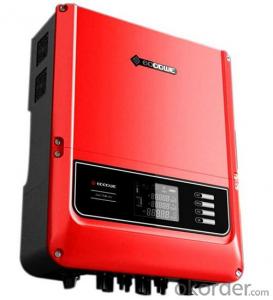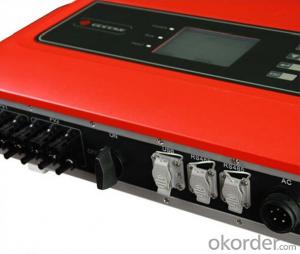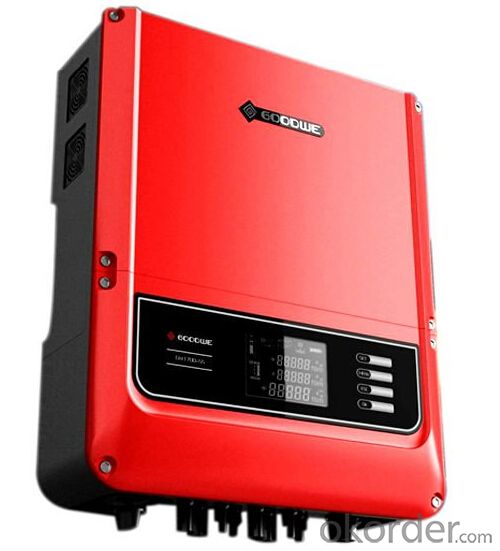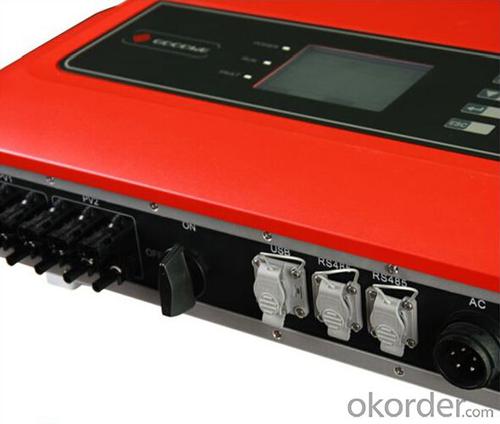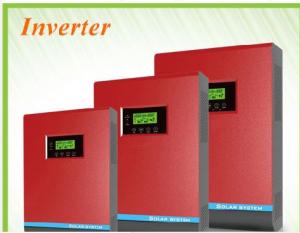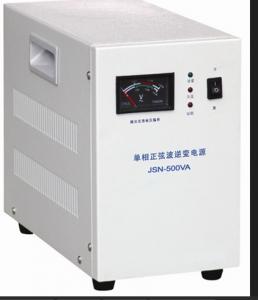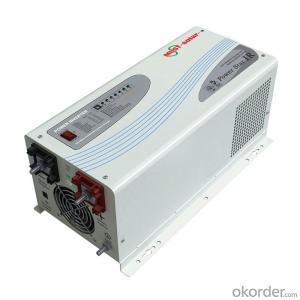Japanese Solar Inverter On Grid GW17K-DT
OKorder Service Pledge
OKorder Financial Service
You Might Also Like
GW17K-DT
GW17K-DT photovoltaic inverter is suitable for commercial and industrial roofs as well as small and medium-sized photovoltaic power systems.
The optimized inductor design ensures less noise and higher European efficiency.
The reliable grid support capabilities, high waterproof and dustproof grade and extra-wide voltage access range of components not only can be used in commercial roof and commercial power station systems,
but also is qualified for the design requirements of large-megawatt power station.
Datasheet
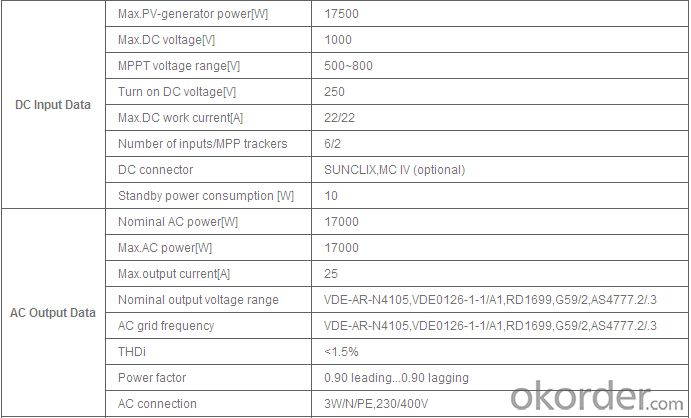
- Q: What is the role of a grid-tie inverter in a solar PV system?
- The role of a grid-tie inverter in a solar PV system is to convert the direct current (DC) electricity generated by the solar panels into alternating current (AC) electricity that can be used to power electrical devices in a home or business. In a solar PV system, the solar panels produce DC electricity when exposed to sunlight. However, most homes and businesses use AC electricity, which is the standard form of electricity provided by utility companies. This is where the grid-tie inverter comes in. The grid-tie inverter takes the DC electricity produced by the solar panels and converts it into AC electricity that is compatible with the electrical grid. It ensures that the electricity generated by the solar panels is synchronized with the utility power and can be seamlessly integrated into the existing electrical system. One of the key functions of a grid-tie inverter is to match the frequency, voltage, and phase of the AC electricity generated by the solar panels with that of the utility power. This synchronization is crucial to ensure a smooth flow of electricity between the solar system and the grid, and to prevent any disruptions or damage to the electrical system. Additionally, a grid-tie inverter also monitors the electrical grid for safety reasons. It constantly checks the grid for any voltage or frequency fluctuations and can automatically disconnect from the grid in the event of a power outage or grid failure. This feature is important to protect the safety of electrical workers who may be repairing the grid during an outage. Furthermore, a grid-tie inverter allows for net metering, which is a billing arrangement where excess electricity generated by the solar system can be fed back into the grid. This means that if the solar system produces more electricity than is being used, the excess energy can be sent back to the grid and the homeowner or business owner can receive credits for the excess energy produced. This can help offset energy costs and potentially result in monetary savings. Overall, the grid-tie inverter plays a vital role in a solar PV system by converting the DC electricity generated by the solar panels into AC electricity that can be used to power electrical devices, ensuring synchronization with the electrical grid, monitoring the grid for safety, and enabling net metering for potential financial benefits.
- Q: Can a solar inverter be used with different types of solar panels?
- Yes, a solar inverter can typically be used with different types of solar panels. Solar inverters are designed to convert the direct current (DC) generated by solar panels into alternating current (AC) that can be used to power various electrical devices. As long as the solar panels produce compatible DC voltage and current, they can be connected to the solar inverter regardless of their type, such as monocrystalline, polycrystalline, or thin-film panels. However, it is important to ensure that the solar inverter is appropriately sized and compatible with the total capacity of the connected solar panels for optimal performance.
- Q: What is the expected lifespan of a solar inverter?
- The expected lifespan of a solar inverter typically ranges from 10 to 20 years. However, this can vary depending on factors such as the quality of the inverter, maintenance practices, and environmental conditions.
- Q: Can a solar inverter work without batteries?
- Yes, a solar inverter can work without batteries. In a grid-tied solar system, the solar inverter converts the DC power from the solar panels into AC power that can be used in the household or fed back into the grid. Batteries are not necessary as the system relies on the grid for power supply during periods of low or no sunlight.
- Q: What is the role of a display or user interface in a solar inverter?
- The role of a display or user interface in a solar inverter is to provide real-time information and control capabilities to the user. It allows the user to monitor the performance of the solar inverter, such as the amount of power being generated, the voltage and current levels, and any error or warning messages. The display also enables the user to adjust various settings and parameters of the inverter, such as the operating mode, output voltage, or charging profiles. In essence, the display or user interface acts as a communication tool between the user and the solar inverter, facilitating efficient operation, monitoring, and troubleshooting.
- Q: What are the common troubleshooting steps for a malfunctioning solar inverter?
- The common troubleshooting steps for a malfunctioning solar inverter include checking the display for error messages, inspecting the DC and AC connections for loose or damaged wires, verifying the input voltage and frequency, resetting the inverter, and monitoring the system for any unusual behavior. If these steps do not resolve the issue, it is advisable to consult a professional or contact the manufacturer for further assistance.
- Q: Can a solar inverter be used with different types of grid connection standards?
- Yes, a solar inverter can be used with different types of grid connection standards. Solar inverters are designed to convert the direct current (DC) generated by solar panels into alternating current (AC) that can be fed into the electrical grid. They are manufactured to comply with various grid connection standards and regulations, allowing them to be compatible with different types of grids worldwide. This flexibility enables solar inverters to be used in a wide range of countries and regions with varying grid connection requirements.
- Q: How does a solar inverter handle grid islanding conditions?
- A solar inverter detects grid islanding conditions by monitoring the voltage and frequency of the grid. When it detects a deviation from the normal range, indicating an islanding event, it immediately stops supplying power to the grid. This is done to ensure the safety of utility workers who may be repairing the grid.
- Q: What is the role of a fault detection feature in a solar inverter?
- The role of a fault detection feature in a solar inverter is to monitor and identify any malfunctions or abnormalities within the system. It is responsible for detecting faults such as overvoltage, under-voltage, over-temperature, short circuits, ground faults, or any other potential issues that may arise. This feature helps ensure the safe and efficient operation of the solar inverter by promptly alerting the user or system operator about the fault, allowing for quick troubleshooting and maintenance.
- Q: What safety features should a solar inverter have?
- A solar inverter should have several safety features, including overvoltage protection, overcurrent protection, ground fault protection, and arc fault protection. Additionally, it should have robust insulation to prevent electrical shock hazards and be equipped with sensors to monitor temperature and prevent overheating. Finally, it should have a secure enclosure to protect against environmental factors such as water, dust, and debris.
Send your message to us
Japanese Solar Inverter On Grid GW17K-DT
OKorder Service Pledge
OKorder Financial Service
Similar products
Hot products
Hot Searches
Related keywords
